
Due to the government shutdown, ARC WEPTAC and M.A.G. Exchange are shifting from October 20-21 to December 7-8 at the Hilton DoubleTree Hotel-Tucson Airport.

Due to the government shutdown, ARC WEPTAC and M.A.G. Exchange are shifting from October 20-21 to December 7-8 at the Hilton DoubleTree Hotel-Tucson Airport.
Ski, Norway / Labarthe-sur-Lèze, France — October 7, 2025
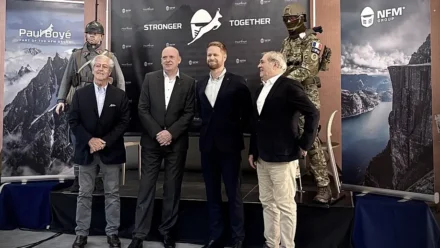
The Norwegian personal protective equipment company, NFM Group has completed the acquisition of Paul Boyé, one of France’s most established defense and security manufacturers. The transaction marks a new stage in NFM Group’s European expansion and reinforces its long-term commitment to the French Armed Forces and national security institutions.
Following a comprehensive process with French authorities, NFM Group has acquired 100% of the shares in Paul Boyé . The Closing was finalised on October 7th 2025, with the transfer of ownership taking effect the same evening.
From heritage to horizon: A new chapter for Paul Boyé and NFM Group
Founded in 1904, Paul Boyé supplies protective and operational systems to armed forces, law enforcement, first responders, and the health sector, continuing a legacy of more than a century of experience. The company is a recognized expert in CBRN protection, and a trusted supplier of tactical equipment, as well as technical uniforms and protective garments used in demanding operational environments.
NFM Group, founded in Norway in 1996, has grown from a small start-up to a global defense supplier with operations across Europe and the United States. Following the acquisition of the German company Hexonia in 2022, NFM Group has built a strong and strategically positioned European industrial footprint.
“This acquisition reinforces our long-term partnership with France — one of our most important and trusted defense markets,” said Walter Øverland, CEO of NFM Group.
“It secures industrial continuity, strengthens local presence, and ensures that key capacities remain in France.”
“Secondly, it significantly expands our European footprint and strengthens the Group’s overall capabilities — from research and design to full-scale production and lifecycle support. Together, we are building a stronger, more resilient European defense industry.”
Jacques and Philippe Boyé, the previous owners added;
“We are very happy to hand over the reins to NFM Group given its managerial and industrial qualities. This acquisition ensures the continuity of Paul Boyé, to which we are deeply attached. We can leave with peace of mind after having dedicated 50 years of our lives to the company.”
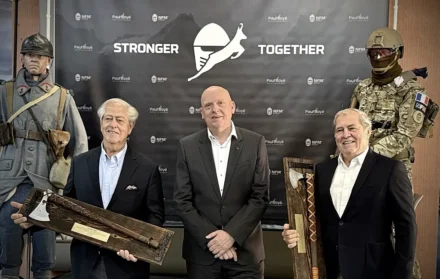
From the left: Philippe Boyé, Walter Øverland, Jacques Boyé
A European footprint
The addition of Paul Boyé further strengthens NFM Group’s European industrial network, creating powerful synergies across the continent. Together, these companies expand the Group’s capacity to deliver complete protection systems — including body armor, helmets, uniforms, CBRN protection, firefighter equipment, and advanced logistics and recycling solutions — supported by R&D and production capabilities across Europe.
With production sites now spanning Norway, France, Germany, Poland, Bulgaria, the United States, and Madagascar, NFM Group consolidates one of the most comprehensive industrial bases in the European defense sector, ensuring supply chain resilience and operational continuity in times of crisis.
New leadership at Paul Boyé
As part of the integration, Mads E. Larsen, currently Managing Director of NFM France and Chief Strategy Officer of NFM Group, will assume the role of President & CEO of Paul Boyé.
“Paul Boyé is a company with a proud legacy and a significant position in France for more than a century — as well as an international presence through the export of CBRN protection systems,” said Mads E. Larsen.
“In the months ahead, together with the new leadership team at Paul Boyé — and in close partnership with NFM Group — we will define the direction and priorities for the company’s future. It’s an exciting journey that combines respect for the past with the ambition to shape the future.”

Mads E. Larsen, President & CEO of Paul Boyé

WASHINGTON – The U.S. Army is adding 17 new military occupational specialties (MOSs) to its Civilian Acquired Skills Program (ACASP) effective October 1, 2025. The ACASP allows Soldiers with relevant civilian skills to bypass some initial training and start their military careers at an advanced level. This expansion brings the total number of eligible occupations to 60.
“ACASP offers a two-pronged benefit,” said Brig. Gen. Gregory Johnson, Director of Military Personnel Management. “The Army gets skilled specialists into the force faster and at a lower cost, while the Soldier receives a significant head start in their military career.”
Through ACASP, qualified applicants with verified civilian training, certifications, or experience can receive advanced rank, accelerated promotion, or modified training requirements upon enlistment. The latest update authorizes the following 17 new MOSs under ACASP:

While specific requirements vary by career field, all ACASP applicants must meet several general criteria. Candidates need verifiable work experience, training, or certification in a qualifying job and must satisfy all standard Army enlistment requirements, such as age, physical fitness, and background checks. To verify eligibility, applicants must also provide official documentation of their skills, which can include licenses, transcripts, or letters from an employer.
The revised ACASP MOS inventory will be available for applicants entering into the Regular Army, U.S. Army Reserve, and Army National Guard. For more information on the ACASP and the complete list of eligible MOSs, access the Smartbook DA PAM 611-21 here.
By LTC Andrew Yang, U.S. Army Directorate of Military Personnel Management
CZ introduces the CZ 457 Hunter Veil, one of the newest rimfire rifles in the popular CZ 457 series.

Built for stealth and precision, this lightweight rifle combines reliable performance with a modern camouflage design, making it an ideal choice for small game hunters and target shooters alike.
The 457 Hunter Veil features a durable polymer stock wrapped in Veil® Big Sky camouflage with a soft-touch finish, allowing it to blend seamlessly with natural surroundings while providing a secure and comfortable grip in any weather. Designed to withstand harsh field conditions, the stock ensures lasting durability and resistance to wear.
Its 20-inch light-profile barrel and all-metal components are finished in a flat bronze PVD coating, offering exceptional resistance to corrosion and wear while maintaining a low-visibility look in the wild. A mounted compensator reduces muzzle rise for faster, more controlled follow-up shots, and the bolt knob, borrowed from the CZ 600 Trail, provides smooth, consistent cycling.
Features
• Caliber: .22 LR
• Barrel: 20-inch light profile
• Stock: Durable polymer with Veil® Big Sky camouflage and soft-touch finish
• Finish: PVD coating on barrel, receiver, and bolt knob
• Compensator: Helps reduce muzzle rise
• Oversized Bolt Knob: From the CZ 600 Trail
• Overall Length: 39.9 in. (with compensator), 38.6 in. (without)
• Weight: 5.5 lbs
With its refined balance of function, style, and durability, the CZ 457 Hunter Veil delivers top-tier accuracy and rugged performance in a sleek new package, keeping you perfectly in tune with your surroundings and ready for any rimfire adventure.
For more information, visit www.czfirearms.com/en-us.

NEWINGTON, NH, October 8th, 2025 – WILCOX INDUSTRIES, a global leader in mission-critical integrated headborne and combat systems, is proud to announce its partnership with RIVET INDUSTRIES, a defense technology innovator, at the upcoming AUSA Annual Meeting & Exposition in Washington, DC, taking place October 13–15, 2025. RIVET will be exhibiting its advanced HUD technology at WILCOX’s Booth, showcasing how its integrated solution supports the U.S. Army’s evolving Soldier as a System vision.
Designed for the Soldier Borne Mission Command (SBMC) program, RIVET’s rugged, glasses-based HUD fuses data from Soldiers, sensors, and mission systems into a single operational picture, enhancing situational awareness and decision-making in any environment, day or night.
Through integration with WILCOX’s MANTIS™ mounting solution, the RIVET HUD becomes part of the FUSION CLAW-compatible system, seamlessly connecting individual warfighters to squad and command networks. This integrated approach supports maneuvering, targeting, and real-time data sharing, aligning with the Army’s focus on digital transformation and network-centric warfare, while managing the available power worn by the Soldier.

“This partnership embodies the next generation of battlefield technology,” said Jim Teetzel, CEO of WILCOX. “By integrating RIVET’s HUD with our FUSION CLAW™ platform, we’re delivering scalable, interoperable solutions that directly support the Soldier as a System vision and empower the modern warfighter.”
“The Army’s SBMC program is about creating a connected, informed, adaptable, and most importantly, more lethal Soldier,” said Dave Marra, CEO of RIVET. “By partnering with WILCOX, we’re accelerating that vision, bridging sensors, power, and data into a single, Soldier-ready capability.”
Attendees at AUSA 2025 will have the opportunity to engage directly with both WILCOX and RIVET teams and experience an interactive feature demonstration of the FUSION CLAW with RIVET’s HUD system.
ALLENTOWN, PA – October 7, 2025 – Mack Defense announced it has received an initial order for 86 M917A3 Heavy Dump Trucks (HDTs) from the U.S. Army as part of a new five-year contract awarded June 24, 2025, for up to 450 trucks with value up to $221.8 million. This order is the first under the new contract and follows the successful completion of Mack Defense’s original seven-year contract awarded in 2018.

Mack Defense announced it has received an initial order for 86 M917A3 Heavy Dump Trucks (HDTs) from the U.S. Army as part of a new five-year contract awarded June 24, 2025, for up to 450 trucks with value up to $221.8 million.
“We are proud to continue supporting the U.S. Army with proven, reliable vehicles tailored to the demands of military operations,” said Derik Beck, senior director of sales, business development and marketing at Mack Defense. “This new order and the new contract overall both reinforce the critical role the M917A3 plays in sustainment missions and reflect the trust the Army has placed in our team, our truck and our American manufacturing operations. Leveraging a commercially proven platform like the Mack® Granite®allows the Army to benefit from an established supply chain, proven durability and easier lifecycle support across a wide operational footprint.”
Funding for the 86 trucks comes from the 2025 Department of Defense Budget, a signal of continued federal support for tactical vehicle modernization and U.S. industrial base readiness.
The trucks will be used across a wide range of operational environments in support of critical infrastructure and construction efforts, including airfields, roadways, landing strips, supply facilities and motor pools.
The M917A3 HDT is based on the Mack Granite commercial platform, enhanced to meet the U.S. Army’s rigorous requirements. Key modifications include all-wheel drive, heavier-duty rear axles, increased ride height and other ruggedized features for tactical use. Each truck is also equipped with modern control systems, ABS and advanced safety technology, providing operators with improved handling, performance and mission flexibility.
All vehicles are assembled at the Mack Experience Center (MEC) in Allentown, Pennsylvania, where Mack Defense established a dedicated production line in 2021 following a $6.5 million investment. The facility has passed stringent government inspections and quality audits and represents a key component of Mack Defense’s support for the U.S. industrial base.
The M917A3 continues to serve as a core asset for the Army Engineer Regiment, delivering the durability, mobility and engineering capability needed to execute demanding missions across a broad range of environments.
Mack Defense remains committed to delivering high-performance, mission-ready equipment that supports the evolving needs of the U.S. military – today and into the future.
Production of the HDTs began in March of 2021. The productionline helps fulfill the M917A3 contract, while allowing Mack Defense to produce other vehicle variants.

FLORENCE, Texas – (October 08, 2025) – Staccato2011®, the creators of the 2011® pistol platform, today announced a new addition and newest innovation to its HD line of 2011 pistols, the HD C3.6.
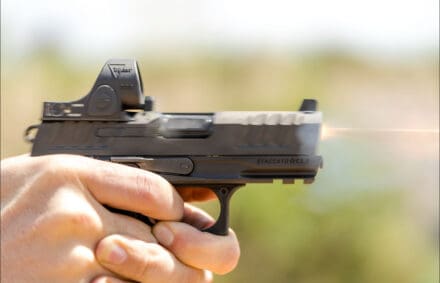
Designed to offer the unrivaled performance Staccato’s HD line has become known for, speed, precision and enhanced control, the HD C3.6 is optimized for user-friendly carry with a compact and ergonomic build, improving concealability.

“We built the HD line to deliver the most technologically advanced and thoroughly tested version of the 2011 platform to date,” said Paul Smith, VP of Product for Staccato. “After introducing full-sized models earlier this year, we set out tocreate a compact option that preserves duty-grade performance while expanding carrying options and user confidence. The HD C3.6 is the result.”

The HD C3.6, Staccato’s inaugural HD carry model, features a 3.6-inch barrel and includes two 15-round metal Mec Gar magazines. To ensure it’s the ideal choice for convenient carryand unrivaled performance, it features the cutting-edge upgrades Staccato introduced with the full-size HD pistols after years of feedback from Staccato’s elite professional end-users.
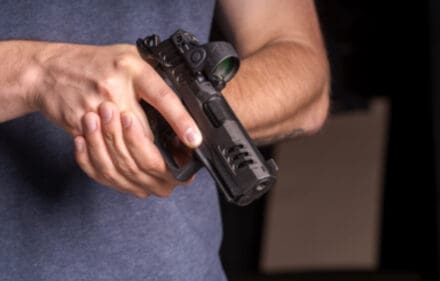
Key features of the HD C3.6 include:
• Aluminum frame with a shortened grip module and carry texture.
• Ambidextrous controls.
• HD HOST optic-mounting system.
• Improved recoil system.
• Active firing-pin block.
• Glock® pattern magazine compatibility.
The HD C3.6 starts at an MSRP of $2,299 and will be available from authorized dealers. To learn more about the HD C3.6 or to view the full Staccato lineup, visit www.staccato2011.com or follow @staccato2011 on Instagram.
McLean, VA — October 8, 2025) FN America, LLC is pleased to announce that it has delivered test and evaluation samples of two all-new weapon systems – LICC-IWS and LICC-AMG – along with ammunition as part of a long-term development contract with the Department of Defense’s Irregular Warfare Technical Support Directorate (IWTSD). FN also conducted new equipment training (NET) and armorer’s training for both systems to demonstrate maintenance at the unit level.

FN America developed the weapon systems with feedback from individual operators, based on the U.S. Government goal of providing overmatch against near-peer threats. The systems were recently assigned National Stock Numbers (NSN), simplifying the acquisition process.
The LICC-IWS program is comprised of the 6.5×43 LICC (Lightweight Intermediate Caliber Cartridge) ammunition, the LICC-IWS (Individual Weapon System) with FN® IPC (Improved Performance Carbine), purpose-built magazine and signature suppressor. The LICC-AMG is based on the success of the prototype LICC ammunition and LICC-IWS system and is comprised of the LICC-AMG (Assault Machine Gun) belt-fed machine gun, signature suppressor, family of common ammunition, and lightweight links. Multiple users will test the operational samples , providing critical feedback to aid FN and IWTSD in the final development of the systems.
“FN’s ultimate goal is to advance from development into production and field a final solution that provides operators a system that is easier to operate, more accurate and more effective than anything available today,” said Mark Cherpes, President and CEO for FN America. “After this test and evaluation phase, our plan is to take user feedback, fine-tune the systems and move into low-rate initial production.”
LICC Weapon Systems and Ammunition
FN designed the LICC-IWS individual weapon system to improve lethality, accuracy, durability, balance and handling over the M4A1. The improved performance derives from a new 6.5×43 LICC lightweight ammunition , based on the U.S. Army Marksmanship Unit’s .264 USA; a 25-round purpose-built, polymer magazine; a signature suppressor, and the FN IPC. The FN IPC features a completely new architecture, well-suited to meet the challenging program requirements and address the feedback from operators who have contributed since the beginning of the program.

The LICC-IWS IPC handles much like an M4A1 but with key improvements to deliver a fully ambidextrous platform with unique takedown method and highly adjustable buttstock, which allows for user-selectable left- or right-hand side fold capability. It operates from a robust long-stroke gas piston system and features multiple buffers that reduce felt recoil, resulting in an extremely soft shooting weapon.
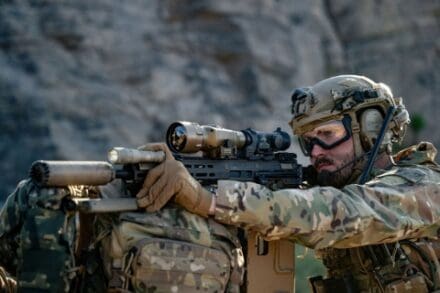
Additionally, it features a unique self-regulating gas system with on-off capability, and newly patented bullet technology developed from efforts to mature the 6.5×43 cartridge, that greatly improve system reliability and accuracy.
The LICC-IWS has been developed and is being tested in three different barrel-length models – a 12.5” Close Quarters Battle option, a 14.5” Carbine option and an 18.0” Designated Marksmanship Rifle option (RECCE).

“Initial test firing results from the U.S. Army Marksmanship Unit and other operators show that the accuracy of the LICC-IWS is consistently two times better than the M4A1,” said Jim Williams, Vice President, Military Programs for FN America. “Additionally, the LICC-IWS handles like the M4A1, yet remains soft shooting when firing the new 6.5×43 lightweight ammunition.”
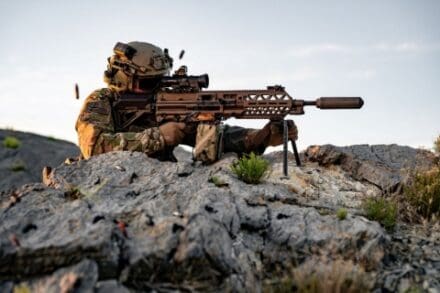
Adapted from the FN Evolys®, the select-fire LICC-AMG is a shoulder-fired, belt-fed lightweight weapon system chambered in 6.5×43 LICC with a continuous monolithic top rail and an innovative side feed featuring a lightweight metallic link. In prototype testing, the AMG was more accurate than the FN MK 48 in full auto mode. Overall, the AMG demonstrated improved performance in lethality, accuracy, durability, balance and handling over the FN M249 and FN MK 46/MK 48 machine guns.
“Creating totally unique weapon systems around a specific caliber is in FN’s DNA,” said John Bungard, Sr. Director, Military Development Programs for FN America, LLC. “As our team worked on the LICC-IWS program, quickly followed by LICC-AMG, we were able to leverage our decades of engineering expertise across multiple weapons and ammunition platforms to come up with the ideal solution for today’s global threats.”
FN’s LICC-IWS and LICC-AMG submissions are ground-floor development efforts based on the IWTSD concept and FN’s unique 6.5x43mm LICC caliber developed with input from the U.S. Army Marksmanship Unit, IWTSD and individual operators. A family of lightweight, stainless steel cased 6.5×43 caliber ammunition was designed to reduce the carried weight of the system by 20% compared to equivalent brass cartridges, while achieving improved results in accuracy, range and performance over current fielded 5.56 ammunition, including M855A1 (5.56x45mm).


Irregular Warfare Technical Support Directorate (IWTSD)
 The IWTSD exists to identify and develop capabilities for the Department of Defense (DoD) to conduct irregular warfare against all adversaries, including Great Power competitors and non-state actors. The IWTSD delivers those capabilities to DoD components and interagency partners through rapid research and development, advanced studies and technical innovation, and provision of support to U.S. military operations. In addition, the IWTSD directly manages bilateral agreements with five partner countries: Australia, Canada, Israel, Singapore and the United Kingdom.
The IWTSD exists to identify and develop capabilities for the Department of Defense (DoD) to conduct irregular warfare against all adversaries, including Great Power competitors and non-state actors. The IWTSD delivers those capabilities to DoD components and interagency partners through rapid research and development, advanced studies and technical innovation, and provision of support to U.S. military operations. In addition, the IWTSD directly manages bilateral agreements with five partner countries: Australia, Canada, Israel, Singapore and the United Kingdom.
“FN is excited to partner with the IWTSD to begin final testing and evaluation of the new LICC IWS and AMG systems,” said Bungard. “We cannot wait to get additional user feedback, fine-tune the systems and begin production of what promises to be the next groundbreaking FN platform.”
NSNs Assigned to Select Variants
Three variants of the LICC-IWS have been assigned national stock numbers (NSNs) and are available for requisition by Army, Navy, Marine, Air Force and SOCOM elements and activities. The three variants currently available for request are a 12.5” Close Quarters Battle option, a 14.5” Carbine option and an 18.0” Designated Marksmanship Rifle option, along with two suppressors supporting the system. The NSNs are:
NSN 1005-01-729-0039, FN IMPROVED PERFORMANCE CARBINE 12.5 IN CQB WITH BII*
NSN 1005-01-729-0052, FN IMPROVED PERFORMANCE CARBINE 14.5 IN CQB WITH BII*
NSN 1005-01-729-0046, FN IMPROVED PERFORMANCE CARBINE 18.12 IN REECE (sic) WITH BII*
NSN 1005-01-728-9868, SUPPRESSOR, FLOW 264 FOR IMPROVED PERFORMANCE CARBINE
NSN 1005-01-728-9874, SUPPRESSOR, FLOW 7.62 FOR IMPROVED PERFORMANCE CARBINE
*Basic Issue Items
FN and the U.S. Military
Throughout its history, FN has been one of the largest suppliers of small arms to the U.S. military and continues to develop innovative, future technology. The company currently holds contracts for the FN® M240 and its variants, the FN® M249 lightweight machine gun; the FN® MK 46, MK 48, MK 17 and MK 20 SSR for USSOCOM and various other contracts.
For more information about FN’s military product line or current U.S. military contracts, please visit www.FNAmerica.com.